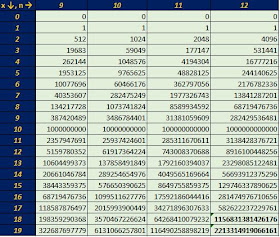Powers of Integers: Last Digit
Let x^n where x is a non-negative integer (x = 0, 1, 2, 3,
…) and n is a positive integer (n = 1, 2, 3, …).
Starting with n = 1, note the last digit of each integer. A table of where 0 ≤ x ≤ 19 and 0 ≤ n ≤ 12 is
shown below:
 |
| x^n: x = 0 to 19, n = 0 to 12 |
Now, let’s look at just the last integer. On Excel, the last digit can be extracted by
the following formula:
=number-ROUNDOWN(number/10,0)*10
Starting to see a pattern? I know this is not a rigorous proof, but four patterns definitely present themselves:
 |
| Last digit of x^n |
Starting to see a pattern? I know this is not a rigorous proof, but four patterns definitely present themselves:
For 1 ≡ n mod 4 (n
= 1, 5, 9…), the last digits of x^n follow this pattern:
0, 1, 2, 3, 4, 5, 6, 7, 8, 9
For 2 ≡ n mod 4 (n
= 2, 6, 10, …), the last digits of x^n follow this pattern:
0, 1, 4, 9, 6, 5, 6, 9, 4, 1
For 3 ≡ n mod 4 (n = 3, 7, 11, …), the last digits of x^n
follow this pattern:
0, 1, 8, 7, 4, 5, 3, 6, 2, 9
And for 0 ≡ n mod 4
(n = 4, 8, 12, ….), the last digits of x^n follow this pattern:
0, 1, 6, 1, 6, 5, 6, 1, 6, 1
Eddie
This blog is property of Edward Shore. 2015.

